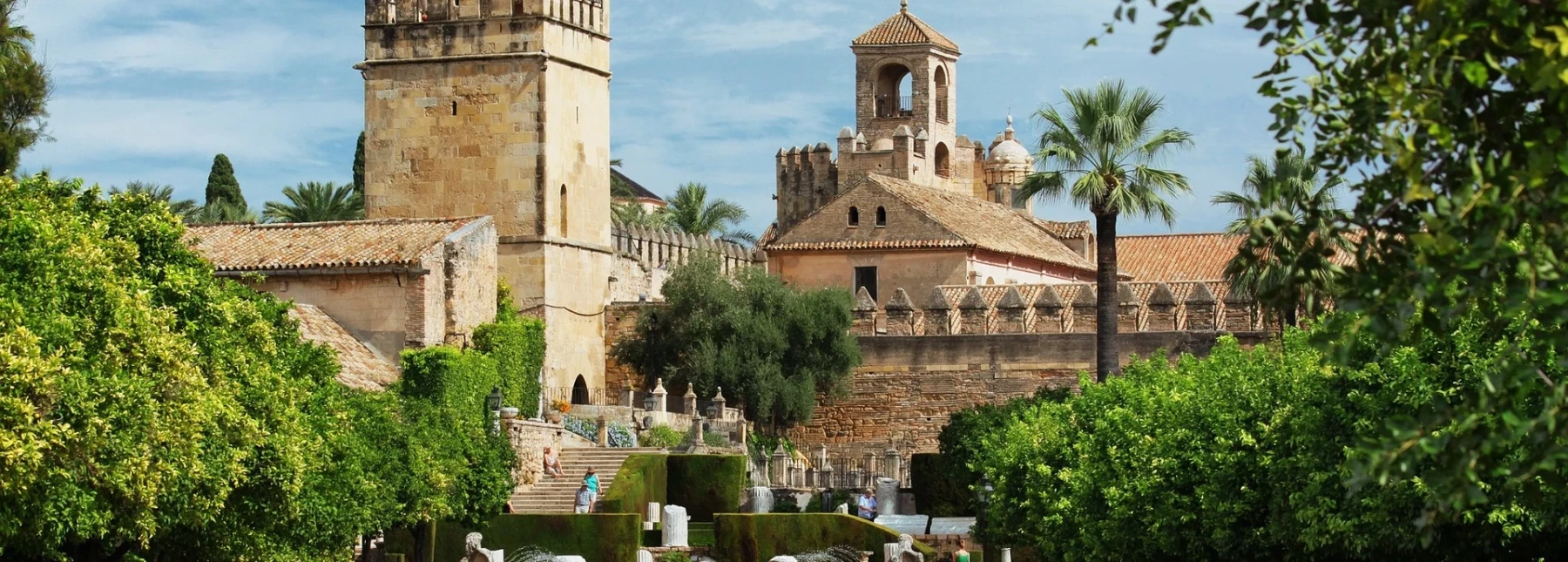To visit - Cordoba
Cordoba, located in the south of Spain, is a city steeped in history, culture, and architecture. As you wander through its narrow, winding streets, you're transported through the ages, from the Roman era to the golden age of Muslim Spain, and into the Christian period.
The centerpiece of Cordoba is the Great Mosque-Cathedral, a masterpiece of Islamic architecture built in the 8th century. Its impressive forest of columns and red and white arches dazzle you as soon as you step through its doors. Inside, you'll discover a fascinating juxtaposition of architectural styles, reflecting the various ruling periods in the region.
Next to the mosque-cathedral lies the Jewish Quarter, a maze of picturesque alleys, flower-filled patios, and whitewashed houses. It's an ideal place to wander, explore artisan shops, and sample tapas in local taverns.
Don't miss the Roman Bridge of Cordoba, which majestically spans the Guadalquivir River and offers stunning views of the city. And for an unforgettable culinary experience, indulge in the local cuisine, which skillfully blends Arab, Jewish, and Spanish flavors.
In essence, Cordoba is an enchanting destination where history, culture, and gastronomy come together harmoniously to offer an unforgettable travel experience.
Discover the 12 must-sees of Córdoba: not to be missed during your visit :
Summary
- To visit
-
- 1 - The Mosque-Cathedral of Córdoba (La Mezquita-Catedral)
- 2 - The Jewish Quarter (Judería)
- 3 - The Alcazar of the Reyes Cristianos
- 4 - The Roman Bridge (Puente Romano)
- 5 - Cordoba patios
- 6 - The Calahorra Tower (Torre de la Calahorra)
- 7 - The Arab baths (Baños Árabes)
- 8 - The Palace of Viana (Palacio de Viana)
- 9 - The museums of Cordoba
- 10 - Parties and festivals
- 11 - Flamenco shows
- 12 - Andalusian gastronomy
- Cordoba - Where to Stay?
- Cordoba - How to get around?
- Cordoba - Best period
1 - The Mosque-Cathedral of Córdoba (La Mezquita-Catedral)
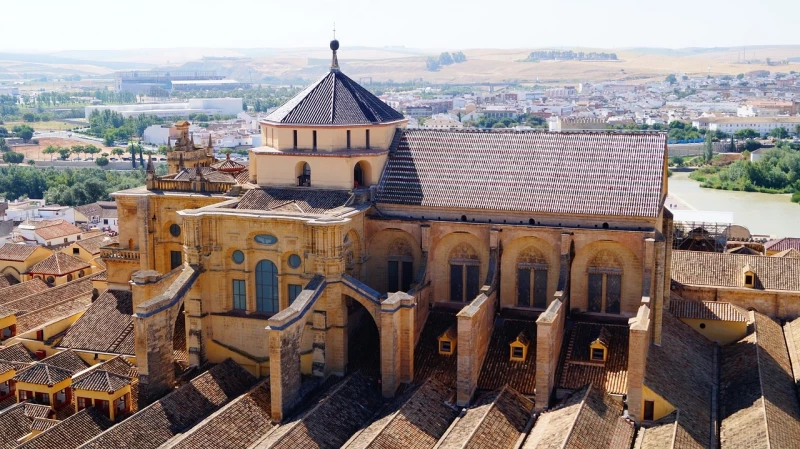
The Mosque-Cathedral of Cordoba, also known as the Mezquita, is one of Spain's most iconic landmarks. Its history dates back to the time of Moorish rule in Spain, when Cordoba was the capital of the Umayyad Caliphate in the 10th century. Originally, it was a small Visigothic church, but when the Moors conquered the Iberian Peninsula in the 8th century, they built a mosque in its place.
The mosque underwent several expansions over the centuries, reaching its zenith under the rule of Caliph Al-Hakam II in the 10th century. The current structure is a fascinating blend of Islamic and Christian architecture, featuring horseshoe arches, marble columns, and intricate decorations.
After the Christian Reconquest of Cordoba in 1236, the mosque was converted into a Christian cathedral. This led to subsequent Christian additions, including the construction of a cathedral at the heart of the mosque. Despite these additions, the mosque still retains much of its Islamic character, making it a symbol of the coexistence of Muslim and Christian cultures in Spain.
Today, the Mosque-Cathedral of Cordoba is one of Spain's top tourist attractions, drawing visitors from around the world for its architectural beauty and historical significance. It was declared a UNESCO World Heritage Site in 1984.
 Our tips for getting the most out of your experience.
Our tips for getting the most out of your experience.
If you're planning to visit the Mosque-Cathedral of Cordoba, here are some tips for a pleasant experience:
-
Purchase Tickets in Advance: The Mosque-Cathedral is a highly popular attraction, especially during peak seasons. Buying your tickets online in advance can save you time by avoiding queues.
-
Plan Your Visit: The Mosque-Cathedral is vast and has many intricate details to discover. Plan your visit in advance by identifying the main points of interest you want to see.
-
Check Opening Hours: Make sure to check the opening hours before you go. The Mosque-Cathedral may have different opening hours depending on the season and holidays.
-
Appropriate Attire: As the Mosque-Cathedral is a place of worship, appropriate attire is recommended. Avoid wearing short or revealing clothing and ensure your shoulders and legs are covered.
-
Explore at Your Own Pace: Take your time to explore the Mosque-Cathedral. Admire the remarkable architecture, horseshoe arches, marble columns, and beautiful artistic details.
-
Tour Guides: If you want to learn more about the history and architecture of the Mosque-Cathedral, consider taking a tour guide. They can provide valuable insights and interesting anecdotes.
-
Night Visits: Some times of the year offer the opportunity to visit the Mosque-Cathedral at night, creating a unique and magical atmosphere with special lighting.
-
Explore the Surroundings: After visiting the Mosque-Cathedral, take time to explore the charming streets of Cordoba, its picturesque squares, and delightful local restaurants.
By following these tips, you can fully enjoy your visit to the Mosque-Cathedral of Cordoba and make it a memorable experience.
2 - The Jewish Quarter (Judería)
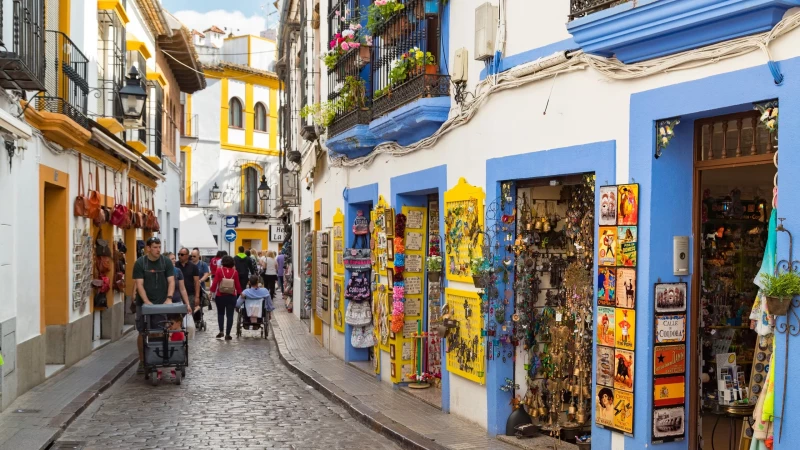
The Jewish quarter of Cordoba, also known as the Judería, is one of the most emblematic neighborhoods in the city. Situated in the historic heart of Cordoba, Spain, it bears witness to the rich and complex history of the city, where Muslim, Jewish, and Christian cultures coexisted for centuries.
The Judería is a labyrinth of narrow streets, shaded courtyards, and whitewashed houses, typical of Andalusian architecture. This neighborhood was home to Cordoba's Jewish community for centuries, reaching its peak during the period of Muslim rule in Spain when Cordoba was the capital of the Umayyad Caliphate.
One of the most remarkable sites in the Judería is the Synagogue of Cordoba, one of the few preserved medieval synagogues in Spain. Built in the 14th century, it bears witness to the Jewish presence in the city during that time.
Another major attraction in the Judería is the famous Mosque-Cathedral of Cordoba, a symbol of Islamic architecture in Spain. This mosque, converted into a cathedral after the Reconquista, reflects Cordoba's complex history, where religious buildings have been reused and reinterpreted over the centuries.
Today, the Judería is a picturesque neighborhood where visitors can stroll through cobblestone streets, discover artisan shops, taste local cuisine in traditional restaurants, and admire historical architecture. It is also a place steeped in memory and symbolism, reminding us of the importance of peaceful coexistence between different cultures and religions.
 Our tips for getting the most out of your experience.
Our tips for getting the most out of your experience.
If you're planning to visit the Judería in Cordoba, here are some tips to enhance your experience:
-
Timing: Try to visit the Judería early in the morning or late in the afternoon to avoid crowds of tourists.
-
Map and Navigation: The narrow streets of the Judería can be a maze. Make sure you have a map or a navigation app on your phone to help you navigate.
-
Guided Tour: Consider taking a guided tour to uncover the hidden secrets of the Judería and learn more about its fascinating history.
-
Cuisine: Don't miss out on tasting local specialties in the bars and restaurants of the Judería. Try dishes like salmorejo, flamenquín, and traditional tapas.
-
Shopping: Explore small craft shops to find unique souvenirs such as pottery, ceramics, and handmade jewelry.
-
Hidden Patios: Don't limit yourself to the main streets. Explore the smaller alleys to discover hidden courtyards adorned with flowers and plants, typical of Andalusian architecture.
-
Photography: The Judería offers plenty of photography opportunities with its picturesque streets, whitewashed houses, and colorful patios. Make sure to have your camera ready.
-
Respect the Quiet: The Judería is also a residential area. Respect the tranquility of the residents and avoid making too much noise, especially in the evening.
By following these tips, you'll be able to fully enjoy your visit to the Jewish quarter of Cordoba and discover all its charms.
3 - The Alcazar of the Reyes Cristianos
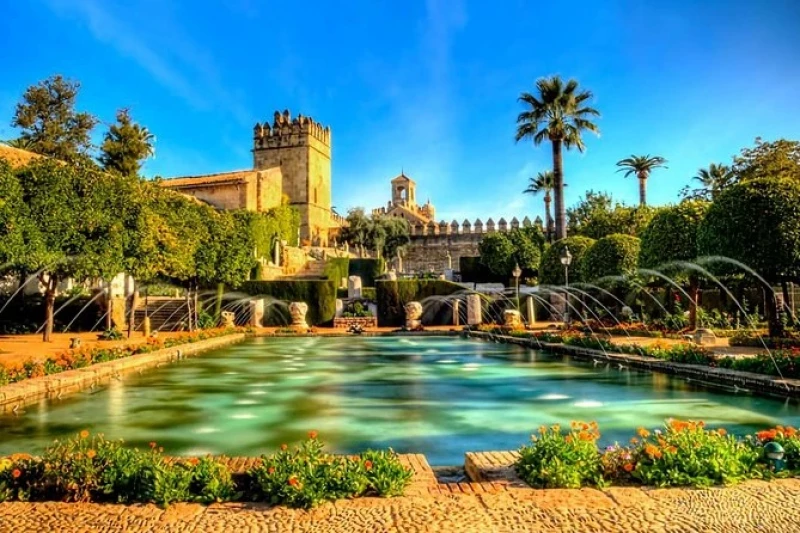
The Alcazar of the Christian Monarchs, located in Cordoba, Spain, is a palace built in the 14th century on the site of a former Moorish palace. This majestic complex is rich in history, having served as a royal residence, a defensive fortress, and even as the seat of the Spanish Inquisition.
The name "Alcazar of the Christian Monarchs" comes from its use as the residence of Catholic monarchs after the reconquest of Cordoba by Christians.
The Alcazar is renowned for its stunning gardens, which blend elements of Moorish architecture with more European styles. The gardens are a place of tranquility and beauty, featuring fountains, pools, and lush vegetation.
Among the main attractions of the Alcazar are its impressive walls and towers, offering panoramic views of the city of Cordoba and the nearby Mosque-Cathedral, another important historical and architectural site in the city.
Today, the Alcazar of the Christian Monarchs is open to visitors who wish to explore its fascinating history and admire its imposing architecture.
4 - The Roman Bridge (Puente Romano)
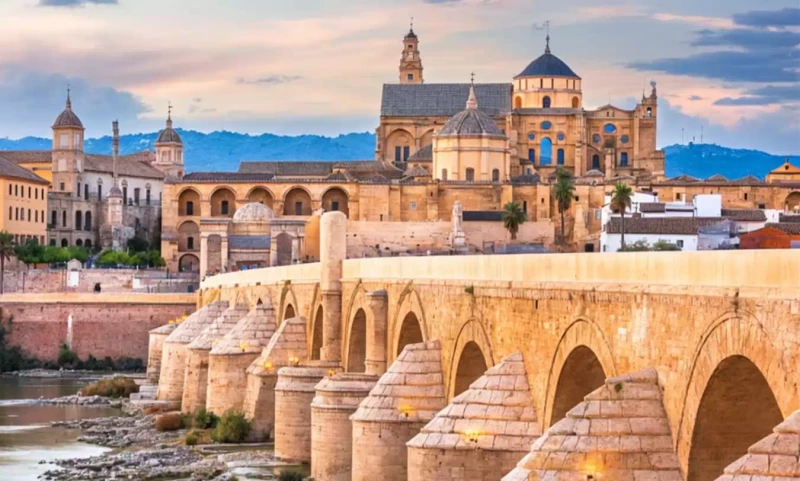
Le Pont Romain, also known as Puente Romano, is a historic bridge located in Cordoba, Spain. This ancient bridge spans the Guadalquivir River and is one of the most iconic landmarks in the city. It dates back to the 1st century BC and was originally built by the Romans. However, it has undergone several renovations and modifications over the centuries.
The bridge consists of 16 arches and is constructed using stone blocks. It served as a crucial crossing point over the river during the Roman era, facilitating trade and communication between different parts of the region. Over time, it also played a significant role in the development and history of Cordoba.
Today, the Puente Romano remains a popular tourist attraction, offering stunning views of the river and the city. It is often featured in postcards and photographs, showcasing its historical significance and architectural beauty. Additionally, it serves as a pedestrian bridge, allowing visitors to stroll across and admire its ancient craftsmanship.
5 - Cordoba patios
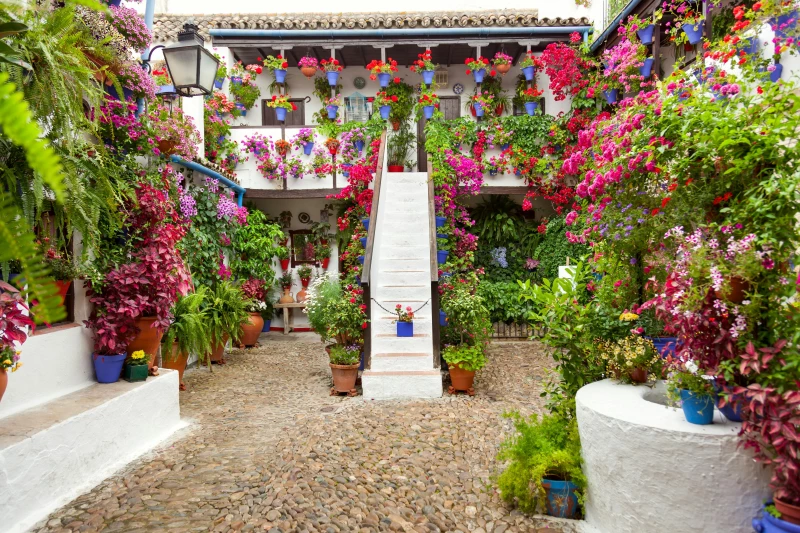
The Cordovan patios are an iconic feature of the architecture of Cordoba, Spain. These patios are interior spaces typically located at the center of houses or buildings, surrounded by walls and often adorned with plants, flowers, and fountains. They serve as a familial and social gathering point and often provide an oasis of coolness during the hot Andalusian summer days. Cordovan patios are famous for their beauty and cultural significance, and they are frequently visited by tourists during the Cordoba Patio Festival, which takes place annually in spring.
6 - The Calahorra Tower (Torre de la Calahorra)
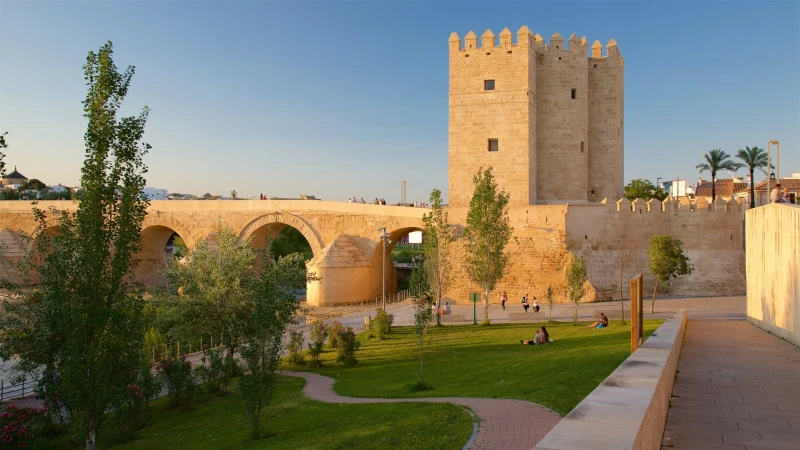
La Tour de la Calahorra, also known as Torre de la Calahorra, is a historic tower located in the city of Cordoba, Spain. It stands at the southern end of the Roman Bridge over the Guadalquivir River, offering a striking architectural presence against the backdrop of the cityscape.
Constructed during the late 12th century, the tower served multiple purposes throughout its history. Originally built as part of the city's defensive fortifications, it later became a gateway to the city and housed a prison. Its design reflects a blend of Moorish, Gothic, and Renaissance architectural styles, showcasing the cultural influences that have shaped Cordoba over the centuries.
One of the tower's most notable features is its horseshoe arches, a characteristic element of Moorish architecture. These arches, along with intricate decorative details, contribute to the tower's aesthetic appeal and historical significance.
In addition to its architectural significance, the Tower of Calahorra also houses the Museum of Al-Andalus Life, which offers insights into the history, culture, and daily life of medieval Andalusia. The museum's exhibits include reconstructions of historical scenes, artifacts, and multimedia presentations, providing visitors with a comprehensive understanding of the region's rich cultural heritage.
Today, the Tower of Calahorra stands as a symbol of Cordoba's diverse history and serves as a popular tourist attraction, drawing visitors from around the world to admire its beauty and learn about its fascinating past.
 Our tips for getting the most out of your experience.
Our tips for getting the most out of your experience.
When visiting the Tower of Calahorra, here are some tips to make the most of your experience:
-
Opening Hours and Crowds: Check the opening hours of the tower in advance and try to plan your visit during off-peak times to avoid crowds.
-
Combined Tickets: Some tourist sites in Cordoba offer combined tickets that include entry to the Tower of Calahorra along with other attractions in the city. Check in advance to see if there are any available offers.
-
Guided Tour: Opt for a guided tour of the tower if possible. Guides can provide detailed information about the history and architecture of the tower, as well as the exhibits in the Museum of Al-Andalus Life.
-
Photography: The tower offers beautiful views of the Roman bridge and the city of Cordoba. Make sure to bring your camera to capture these memorable moments.
-
Time Allocation: Allow plenty of time to explore the tower and museum. Depending on your interest in history and culture, this could take between one to two hours.
-
Comfort: Wear comfortable shoes as you may need to climb stairs or walk distances inside the tower.
-
Respect Rules: During your visit, be sure to respect the rules and guidelines provided by the staff on-site to ensure a pleasant and safe experience for all visitors.
By following these tips, you should be able to fully enjoy your visit to the Tower of Calahorra and learn more about Cordoba's fascinating history.
7 - The Arab baths (Baños Árabes)
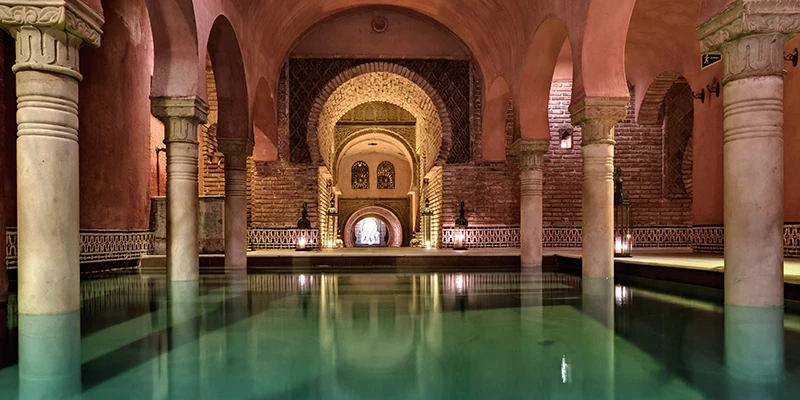
The Arab Baths of Cordoba are a fascinating testament to the rich history of the city. Dating back to the 10th century, these baths, known in Spanish as "Baños Árabes," are one of the few well-preserved remnants of the Muslim period in Cordoba. During the Middle Ages, Arab baths were important social and cultural centers, where people came not only to bathe but also to socialize and debate.
The architecture of the Arab Baths of Cordoba reflects the sophistication and advanced engineering of the Islamic era in Al-Andalus. These baths feature cold, tepid, and hot rooms, as well as a dome structure that allowed for efficient distribution of heat and steam. The baths were also adorned with tiles, stucco, and mosaics, showcasing the exquisite craftsmanship and aesthetic refinement of Islamic culture.
Today, the Arab Baths of Cordoba are a popular tourist destination where visitors can explore these ancient baths and learn more about their history and significance in the daily life of the time. It's a fascinating place to delve into the history of Cordoba and experience the enduring influence of Islamic culture in the region.
8 - The Palace of Viana (Palacio de Viana)
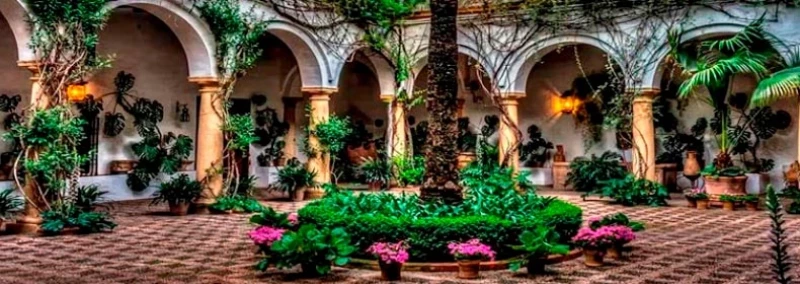
The Palace of Viana in Cordoba, Spain, is a jewel of architecture steeped in history and beauty. Located in the Judería quarter, this palace is a remarkable testament to Andalusian art and architecture.
Built in the 14th century, the Palace of Viana is particularly famous for its magnificent courtyards. These inner courtyards are adorned with fountains, lush gardens, and colorful ceramics, creating an enchanting atmosphere. Each patio has its own style and charm, offering visitors a unique experience at every turn.
In addition to its courtyards, the Palace of Viana also houses an impressive collection of art, antique furniture, and decorative objects. Visitors can explore the various rooms of the palace to discover the history and culture of Cordoba through its rich treasures.
In addition to its historical and artistic significance, the Palace of Viana also hosts concerts, exhibitions, and other cultural events throughout the year, making it a must-visit destination for art and history enthusiasts visiting Cordoba.
9 - The museums of Cordoba
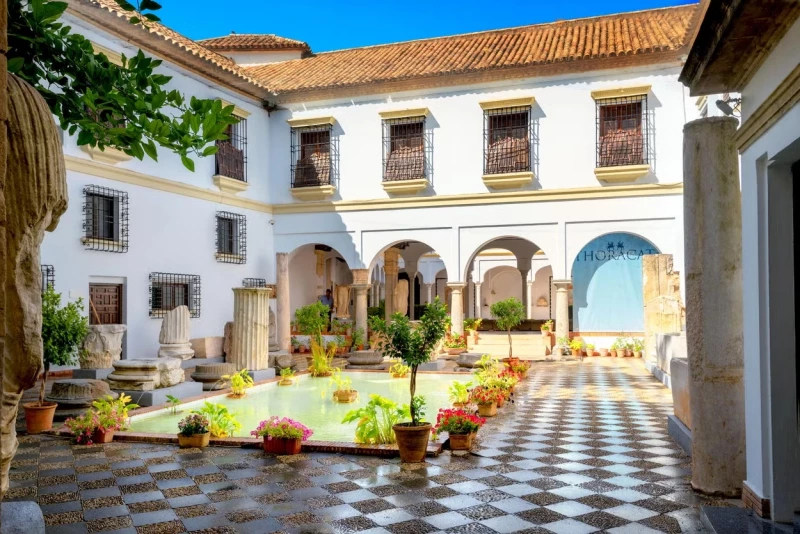
Cordoba, Spain, is a city rich in history and culture, boasting several museums that showcase its fascinating past. Here are some of the most notable museums in Cordoba:
-
The Mosque-Cathedral: While not strictly a museum, the Mosque-Cathedral deserves mention due to its historical significance and architectural beauty. It's one of Cordoba's most famous attractions, blending elements of Islamic and Christian architecture within its interior.
-
Archaeological Museum of Cordoba: Located in the Roman Palace of the Pópulo, this museum houses an impressive collection of artifacts ranging from prehistory to the Roman and Islamic periods. Visitors can explore sculptures, ceramics, jewelry, and other objects that trace the region's history.
-
Julio Romero de Torres Museum: Dedicated to the Cordovan artist Julio Romero de Torres, this museum showcases a collection of his iconic works, including his famous portraits of Andalusian women. It's a great opportunity to discover Spanish art from the early 20th century.
-
Fine Arts Museum of Cordoba: Housed in the former convent of La Madre de Dios, this museum displays a rich collection of artwork spanning from the Middle Ages to the contemporary era. Visitors can admire paintings, sculptures, and decorative objects from various periods and styles.
-
Cordoba Bullfighting Museum: For aficionados of bullfighting, this museum offers a fascinating insight into the history and culture of bullfighting in Spain. Visitors can explore matadors' costumes, bullfighting posters, and other items related to this controversial tradition.
These museums provide a diverse experience, allowing visitors to explore different aspects of Cordoba's history, art, and culture.
10 - Parties and festivals
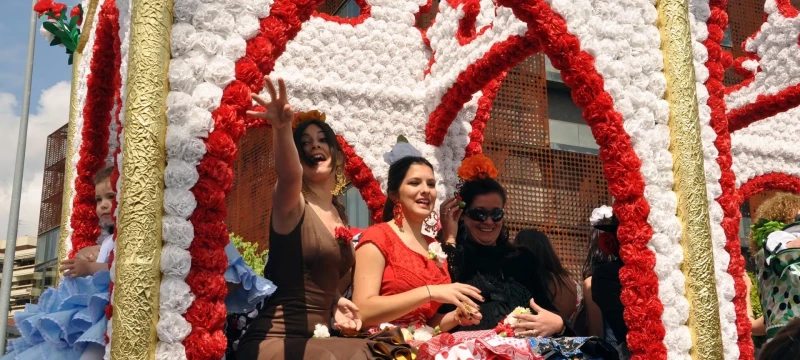
Cordoba, Spain, is a lively city that celebrates numerous festivals and events throughout the year. Here are some of the most important festivals and celebrations in Cordoba:
-
Feria de Nuestra Señora de la Salud: The Fair of Our Lady of Health is Cordoba's most significant event. It typically takes place at the end of May or beginning of June and lasts for a week. During the feria, the city comes alive with concerts, horse parades, flamenco dances, and locals and visitors alike enjoy food and drink stalls.
-
Semana Santa: Like in many Spanish cities, Holy Week is celebrated with grandeur in Cordoba. Impressive religious processions wind through the city streets, with brotherhoods carrying religious statues and richly decorated pasos (religious structures).
-
Festival de Patios: In May, Cordoba hosts the Festival of Patios, where locals open their homes to showcase their flower-decorated patios. It's an opportunity to discover traditional Andalusian architecture and enjoy the beauty of flower-filled courtyards.
-
La Noche Blanca del Flamenco: This annual flamenco festival usually takes place in June and features flamenco dance performances throughout the city, outdoor shows, and concerts in squares and theaters.
-
Carnaval de Cordoba: Although less famous than those in some other Spanish cities, Cordoba's Carnival is still a lively celebration with float parades, costume contests, and street parties.
These festivals and celebrations bring Cordoba to life throughout the year, offering locals and visitors alike the chance to celebrate the city's culture, tradition, and social life.
11 - Flamenco shows
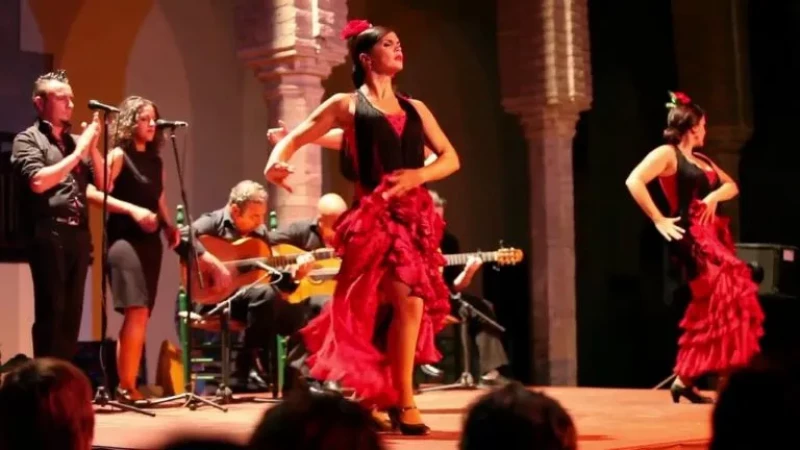
In Cordoba, Spain, you'll find numerous venues where you can experience authentic and captivating flamenco shows. Here are some places where you can enjoy flamenco performances in Cordoba:
-
Tablao El Cardenal: Located in Cordoba's Jewish Quarter, El Cardenal is an intimate tablao known for its high-quality flamenco performances. Shows are accompanied by delicious local gastronomic specialties.
-
Tablao Flamenco Arte y Sabores de Córdoba: This tablao offers authentic flamenco shows in a warm and welcoming atmosphere. You can also enjoy tapas and drinks while watching the performance.
-
Tablao Flamenco La Bulería: Situated in the historic center of Cordoba, La Bulería features live flamenco shows with talented dancers, singers, and guitarists. The intimate and passionate atmosphere ensures an unforgettable experience.
-
Taberna Pepe de la Judería: This traditional taberna hosts flamenco shows several times a week. You can enjoy typical Cordoban dishes while soaking in the lively atmosphere of flamenco.
-
Palacio del Bailío: This historic palace regularly hosts flamenco shows in its magnificent Andalusian courtyard. You can enjoy the performance while immersing yourself in the history and architecture of this iconic venue.
Attending a flamenco show in Cordoba is a must-do experience for any visitor interested in Spanish and Andalusian culture. The passionate performances, enchanting music, and expressive dance make flamenco an art form not to be missed during your stay in Cordoba.
12 - Andalusian gastronomy
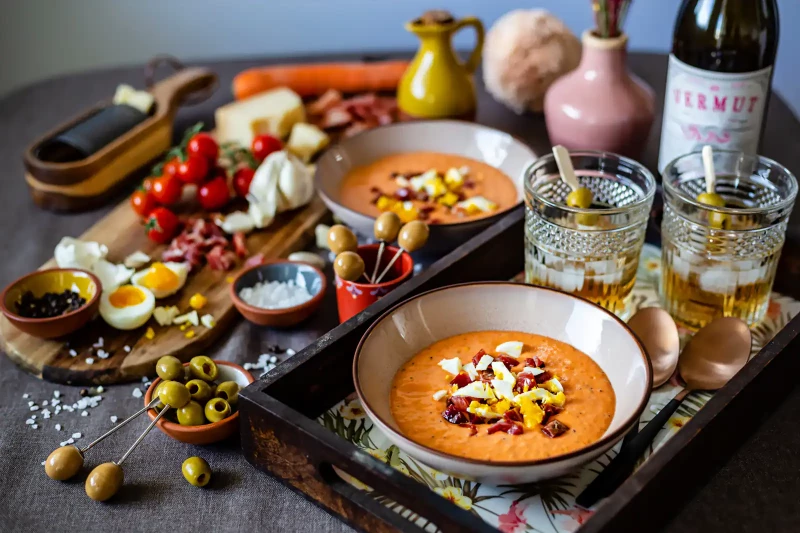
La gastronomie andalouse à Cordoue est une délicieuse fusion de saveurs influencée par sa riche histoire et son patrimoine culturel diversifié. Voici quelques plats traditionnels et spécialités que vous pouvez déguster à Cordoue :
-
Salmorejo : Une soupe crémeuse à base de tomates et de pain, similaire au gazpacho mais plus épaisse et souvent garnie d'œufs durs et de jambon serrano. C'est une entrée rafraîchissante et délicieuse, particulièrement appréciée pendant les chauds mois d'été.
-
Rabo de Toro : Ce ragoût consistant à base de queue de taureau est un plat andalou classique. La viande est mijotée lentement jusqu'à tendreté et parfumée avec une sauce riche à base de vin, de tomates et d'épices.
-
Flamenquín : Un plat cordouan populaire, le flamenquín se compose de tranches de porc ou de jambon roulées et panées, garnies de fromage. Il est ensuite frit à la perfection et servi avec des frites ou de la salade.
-
Berza cordobesa : La version de Cordoue du plat espagnol classique, la berza cordobesa est un ragoût consistant à base de chou, de pois chiches, de pommes de terre et de diverses viandes telles que le chorizo, la morcilla (boudin noir) et le porc.
-
Pastel Cordobés : Une délicieuse pâtisserie fourrée à la citrouille sucrée ou à la patate douce, parfumée à la cannelle et au zeste de citron. Elle est souvent appréciée en dessert ou en en-cas avec une tasse de café.
-
Vins Montilla-Moriles : Cordoue est également réputée pour ses excellents vins, notamment les vins fortifiés de la région de Montilla-Moriles. Ces vins, similaires au xérès, se marient parfaitement avec les plats salés de la région.
-
Mazamorra : Un dessert sucré à base d'amandes moulues, de sucre et de lait, souvent parfumé à la cannelle ou au zeste de citron. Crémeux et indulgent, il est parfait pour satisfaire votre dent sucrée après un repas salé.
Voilà quelques exemples de la délicieuse gastronomie andalouse que vous pouvez déguster à Cordoue. La scène culinaire de la ville offre une riche palette de saveurs et de textures qui reflètent sa culture vibrante et son histoire.
Cordoba - Where to Stay?
To choose where to stay in Cordoba, here are some popular neighborhoods to consider, each offering its own charm and advantages:
-
Old Town (Casco Antiguo): This is the historic heart of Cordoba, where you'll find narrow streets, flower-filled patios, and buildings steeped in history. Staying in this area will put you close to major attractions such as the Great Mosque-Cathedral, the Jewish Quarter, and the Roman Bridge. Accommodation options abound in this area, including hotels, guesthouses, and rental apartments.
-
La Judería (Jewish Quarter): This picturesque neighborhood is known for its winding alleys, shaded courtyards, and charming atmosphere. By staying here, you'll be immersed in Cordoba's Jewish history and within walking distance of many tourist sites. Accommodation options include traditional guesthouses and charming hotels.
-
El Carmen: Located just outside the Old Town, this neighborhood is quieter but still close to major attractions. Here, you'll find an authentic local atmosphere, with cafes, shops, and restaurants frequented by residents. Accommodation options include hotels, rental apartments, and guesthouses.
-
La Axerquía: This neighborhood to the east of the Old Town is a bit more modern and lively, with shopping streets, restaurants, and cafes. By staying here, you'll be close to Cordoba's train and bus stations, which can be convenient if you plan to explore other regions of Andalusia. Accommodation options include chain hotels, apartments, and guesthouses.
Whichever neighborhood you choose, make sure it matches your preferences in terms of ambiance, access to public transportation, and proximity to the attractions you want to visit.
Cordoba - How to get around?
To get around and explore Cordoba, here are some practical options:
-
On foot: Cordoba's historic center is relatively compact and perfect for exploring on foot. You can easily wander through narrow streets, flower-filled courtyards, and major attractions such as the Great Mosque-Cathedral, the Jewish Quarter, and the Roman Bridge.
-
By bike: Cordoba offers a public bike rental system called "Cordoba Ecuestre." You can rent a bike from one of the city's rental stations and pedal along the paved streets to explore the city at your own pace.
-
By taxi: Taxis are available throughout the city and can be useful for getting around longer distances or reaching places further from the city center. Make sure to use an official taxi with a meter.
-
By public transportation: Cordoba has a bus network operated by the company Aucorsa. Buses are an affordable and convenient way to travel throughout the city, including to destinations further afield such as residential areas on the outskirts.
-
By car: If you plan to visit sites outside the city center or explore the surrounding area, renting a car can be a convenient option. However, keep in mind that traffic in Cordoba's historic center can be challenging due to narrow streets and traffic restrictions.
In summary, Cordoba offers several transportation options for visitors, whether it's on foot, by bike, taxi, public transportation, or car, depending on your preferences and specific needs.
Cordoba - Best period
The best time to visit Cordoba depends on your preferences regarding weather and tourist crowds. Here are some points to consider:
-
Spring (March to May): Spring is an ideal time to visit Cordoba. Temperatures are mild and pleasant, typically ranging from 15°C to 25°C. The streets are less crowded than in summer, allowing you to enjoy the tourist attractions more peacefully.
-
Summer (June to August): Summer in Cordoba can be very hot, with temperatures often exceeding 35°C or more. However, if you can tolerate the heat, summer also offers a vibrant atmosphere with many local festivals and events. Make sure to stay well-hydrated and seek out air-conditioned places to cool off.
-
Autumn (September to November): Autumn is another pleasant time to visit Cordoba. Temperatures start to cool down, but remain generally mild, making it ideal for exploring the city. It's also harvest season, with many markets and gastronomic festivals showcasing local delights.
-
Winter (December to February): Winters in Cordoba are mild, but can be cooler and wetter compared to other seasons. Daytime temperatures typically range from 10°C to 15°C. If you prefer to avoid tourist crowds, winter can be a good time to visit, but be sure to pack warm and waterproof clothing.
In summary, spring and autumn are generally considered the best seasons to visit Cordoba due to the pleasant temperatures and moderate tourist crowds. However, each season has its own charms and advantages, so the best time will depend on your personal preferences.
